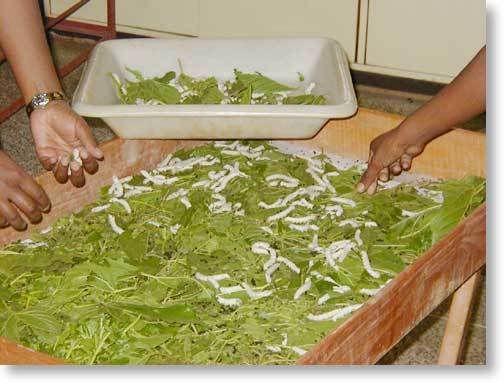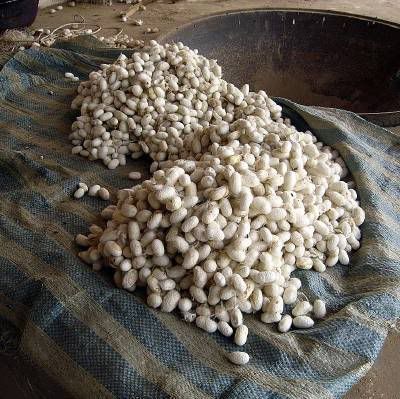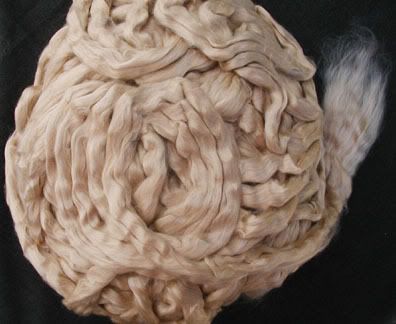 Over two thousand silkworms are needed to produce one pound of silk. That's two thousand silkworms killed by being immersed in boiling water, steaming or drying in an oven for just one pound of silk.
Over two thousand silkworms are needed to produce one pound of silk. That's two thousand silkworms killed by being immersed in boiling water, steaming or drying in an oven for just one pound of silk.
Luckily, there are vegetarian-friendly options if you love the feel of silk. Some silk known as Peace Silk or Vegetarian Silk are harvested from the damaged cocoons after the moth has broken free. Because the silk has been broken into many strands, it is spun like other fibers such as cotton instead of being reeled onto spools. It is not as strong and is slightly discoloured due to the alkaline solution the moth uses to break free of its cocoon.

It's important to ask the right questions when purchasing silk for what you believe is a more ethical and eco-friendly option. For more info, you can click here.
However, please be mindful that any silk is still not vegan as it comes from an animal. Definition of vegan here.
To use silk in soap, dissolve a pinch or no more than one gram of silk for a kilogram of oils in your lye and water solution. It won't dissolve straightaway so you may have to leave it to sit for a while. Give a final stir then use as you normally would.
Below are some companies that offer Peace silk:
USA
Aurora Silk
Ahimsa Peace Silk
Near Sea Naturals
Australia
Mountain Spinnery
Treetops Colours Harmonies
Bright View
All Eco
UK
Denise Bird Woven Textiles
Texere Yarns
The Silk Route

11 comments:
Thank you for all of this information! How interesting.
Thank you so much for this information and especially for the suppliers. I think I may start using silk in my soaps if I can do it consciously. :)
Very informative!
Thank you for posting. I am always amazed how I just never "think" of where something is coming from. I truly never considered that they might be killing moths to get silk...sad on my part.
I have been using tussah silk as well. I think it works great and it certainly makes me glad that millions of worms were not killed for it.
Joanna, Ms In-Between, Trisha: You're very welcome!
Casey: That's alright! It happens to the best of us. I'm glad you found this post informative :)
Sarah: Tussah silk is wonderful and it feels incredible. I also love the warm honey colour that the undyed version has.
You are so pretty Love Miche. And young!
Oh, you're such a sweetheart! Thanks, Joanna :) But I'm afraid it was just good photography.
Wow! Thanks for such great information! You are such a peach! xxoo :o) I agree you are so very pretty! You have the beautiful looks to match the beautiful personality!
You're welcome :D! Awww, thanks Judi! But you really are too kind!
:sigh: I hear this so often. It's just not true.
http://english.dandong.gov.cn/2106/EN_DDS_ZF_ZWGK.nsf/0/F1C73C8D0814293E482570250028923F?OpenDocument
They are indeed raised outdoors, but on plantations of rows of oak trees - they're not wild in the woods any more than sheep or goats. They are watched over, tended, and moved from tree to tree as they eat the leaves up.
Tussah is killed with heat or steam, and reeled in water just like Bombyx. See this page: http://www.hsgwc.co.jp/english/silk_pages/tfy_process.html
or this one: http://www.youfengsilk.com/egylc.asp
The yarns and handspinning fiber are primarily waste, both from breeder cocoons and from off-cuts in the working process. Just this past week, I emailed with a friend of mine, silkmoth entomologist (Dr. Richard Peigler, University of the Incarnate Word) and confirmed this - he just got back from the Tussah-raising regions of China, (mostly Guangdong and Guangzhou) and they only allow enough moths to hatch to perpetuate the crop, just like Bombyx.
There's more, but I can't tell you all the details until he publishes his upcoming book about it. But I can confirm that the moths-emerge part of Tussah culture is just misinformation. It's primarily promulgated by one source on the Web - and I've emailed her and asked her to change her info, and I've emailed her source in India, and HE has asked her to change her info, but she has left much of it in place. There is indeed some sericulture in which the cocoons are not stifled (killed with heat) - but in many of THOSE cases, the pupae are eaten for food. So it didn't die in the cocoon, but it goes to the dinner table.
I know that vegans want to wear and work with silk - who wouldn't? It's fantastic stuff. But I don't think that veganism and silk are compatible, unless you're raising the silkworms yourself, under certain highly controlled conditions, or actually plucking wild cocoons from the trees (which I've done... you can usually find four or five in a good hour's work).
Post a Comment